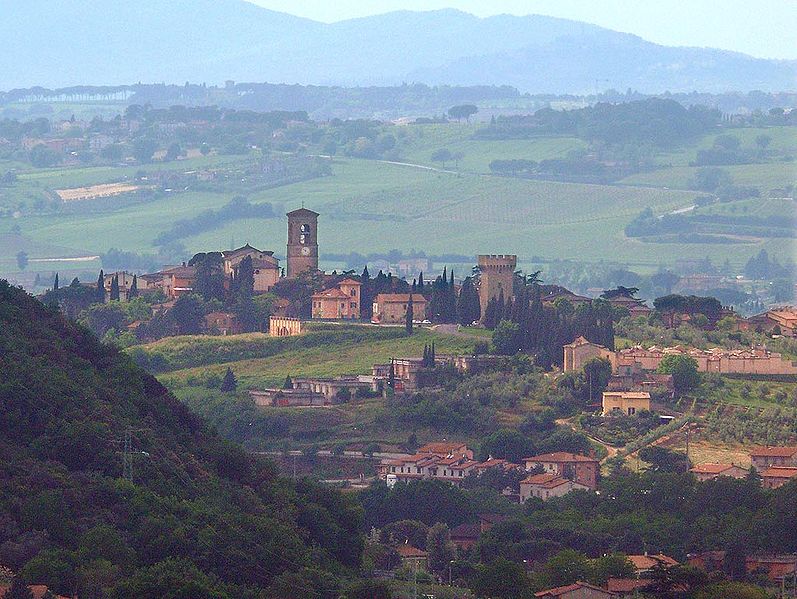
by Patrizia Passerini –
A green heart in the centre of the peninsula, like a treasure chest protected by valleys and hills that follow one another across long distances. Umbria is an Italian region that welcomes visitors with its beauty, rich landscapes and an ancient and amzing history.
Once you arrive in Perugia, you take a narrow and winding road which climbs open and green hills, cultivated with countless rows of vines that let your gaze wander, to reach the ancient village of Torgiano, one of the most beautiful in Italy. The name derives, according to popular tradition, from the Roman origin of the settlement: Torgiano from “Torre di Giano”, (Giano’s tower) from Janus, the two-faced god of Roman culture. In ancient times it was a Roman castrum, placed in a strategic position on a hill, at the confluence of the Chiasco river and the Tiber.
More likely is the Longobard origin of the name, from the Longobard trausan, “to fall down”, referring to the progressive swamping of the base of the hill on which Torgiano stands during the Middle Ages.
The Castle was built during the thirteenth century by the Comune of Perugia, to encourage economic and agricultural expansion towards the Tiber plain. Its position, from which it dominates a large part of the Tiber valley, made it an important military garrison during the Middle Ages.
In 1540 Torgiano escaped the looting that devastated Perugia during the Salt War and to celebrate the inhabitants gave life to the first “infiorata”, an expanse of flowers on the alleys to form colorful carpets, which is repeated every year since then. In the July sunshine, among the narrow streets of the village, tapestries of multicoloured flowers cut through the brick colour with paintings and arabesques, creating fanciful decorations. It is one of the most heartfelt events for the inhabitants, to remember the danger that escaped centuries ago and it attracts many visitors.
Umbria derives its name from the Umbrians, a population that Pliny the Elder called “the oldest in Italy”. The Paleo-Umbrians, who occupied the whole of central Italy, absorbed many cultural stimuli from the Mycenaeans, in the fields of metallurgy, weaving, ceramics and winemaking techniques, as well as linguistic derivations, such as the Umbrian word vinu (“wine” and “vine”), the Latin pampinus (“trellis”) and trebulanum, the Trebbiano wine mentioned by Pliny, which possibly could derive from the toponym trebbio, “inhabited”, from triibom.
Later, the expansion of the Etruscans, the spread of Greek culture and the initiative of the Romans marked the stages of the evolution of the wine culture in Umbria. Still today the wines produced in this land reach an extraordinary quality.
In particular the Etruscans, from the eighth-seventh century B.C., began viticulture in a systematic way, starting from the propulsive centre of Orvieto, as demonstrated by the Etruscan tomb Golini I, found between Orvieto and Porano and dating back to the fourth century B.C., which depicts with exceptional realism the different phases of preparation of the banquet, in relation to the rite of passage of the deceased into the afterlife.
The religious fervour that involved Umbria in the Middle Ages placed wine and vines in a fundamental position, as a beverage to be drunk with moderation in convents, as branches and cuttings that the monks always carried with them during their peregrinations, as an object of representation in many depictions in churches and monasteries. So much that Luca Signorelli, famous Renaissance painter and author of a cycle of frescoes in Orvieto’s Duomo, asked a life annuity of 1000 litres of Orvieto wine every year.
In Torgiano you can see all around endless hills cultivated with vines. The most cultivated grape variety is Sangiovese, at the base of the denomination “Torgiano Rosso Riserva”. Sangiovese, ancient and widespread throughout central Italy, derives from a cross between Ciliegiolo and a minor grape variety from Campania (which could be Calabrese Montenuovo).
In this land there is a very particular microclimate, thanks to the Apennines that protect the area and cause very limited rainfall, in spring and autumn. The composition of the soil, based on clay, sand and pebbles, is very suitable for growing vines.
These elements, togheter with the long aging period (expected for 36 months) makes sangiovese elegant, fine, harmonious, while not losing its structure and exuberance. Torgiano Rosso Riserva wine has great concentration, it’s fruity, spicy and slightly balsamic.
But there is something more. Walking through one of the narrow alleys flanked by the walls of austere medieval palaces, you reach the entrance to MUVIT, “Museo del Vino” (the Wine Museum).
The Museum was founded in 1974, created by Giorgio and Maria Garzia Lungarotti, art and culture lovers and famous wine producers. Today it is managed by the Lungarotti Foundation, directed by Maria Grazia Lungarotti.
Mrs. Maria Grazia Marchetti Lungarotti, art historian and archivist, with a deep culture, animated by the rigor of the scholar, art and archaeology lover, welcomes me with great kindness and elegance. From her words the love and passion for research transpires, pushing her to realize an extraordinary collection over time.
Walking through the palace from one room to another is really surprising, because it’s a unique show, oscillating between wine and art: a museum that literally tells the whole history of wine culture, with a wealth of exhibits ranging from antiquity to the present day.
A collection of finds from various periods and civilizations, by different techniques and materials, made with research, precision, knowledge, determination, rigor, effort, will, love, passion.
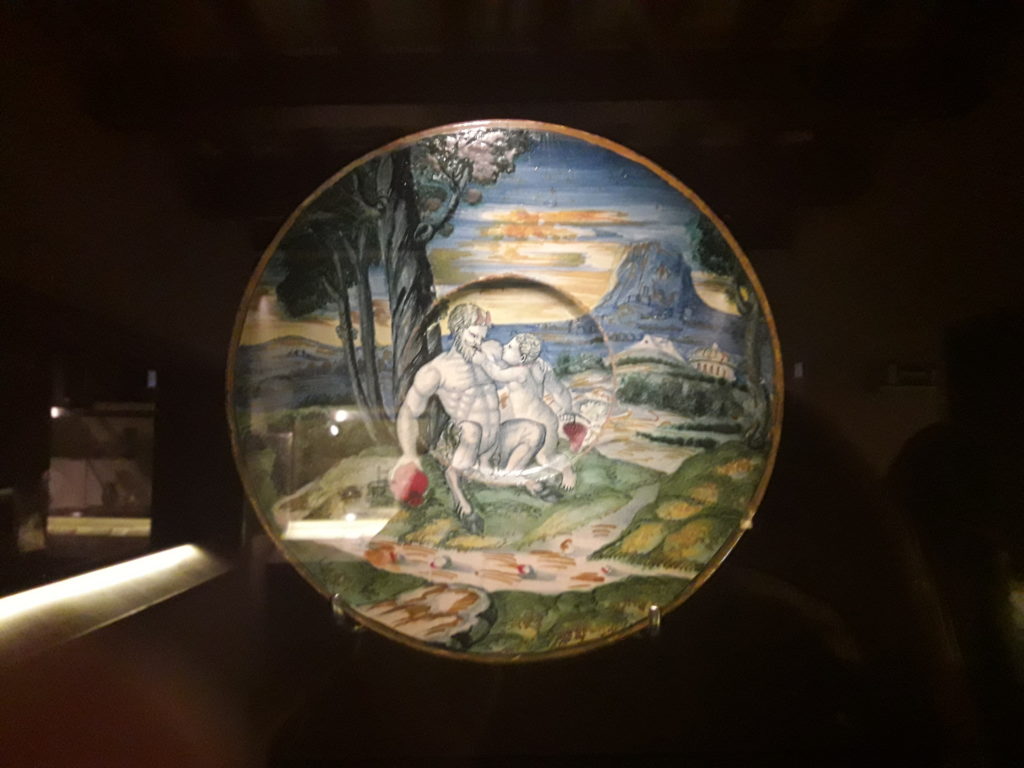
Our gaze can range from the Greek kylixes, to the amphorae used to transport wine on Roman ships, through Renaissance majolica from the most renowned artisan workshops, from the engraving by Andrea Mantegna “Bacchanal with Silenus”, une of the first existing bulin engravings, to the ones by Giovanni Battista Piranesi, from the theatrical sketch “Dionysus” by Renato Guttuso, dated 1980, to “Bacchanal” by Picasso, dated 1957, made with linoleum tecnique, where a visionary and dancing Dionysus almost looks like an Harlequin.
The Museum is housed in the rooms of the seventeenth-century monumental Palazzo Graziani Baglioni and it highlights the cultural aspect of wine, through 5000 years of history. The enhancement of the historical, symbolic and mythological meaning of wine and vines is present in all its forms, through 20 rooms and 3000 artefacts.
According to strict scientific criteria, numerous archaeological finds can be observed, including Cycladic jugs and Hittite vases, Etruscan bucchero cups, Greek and Roman ceramics, glass and bronzes, tools for viticulture and winemaking.
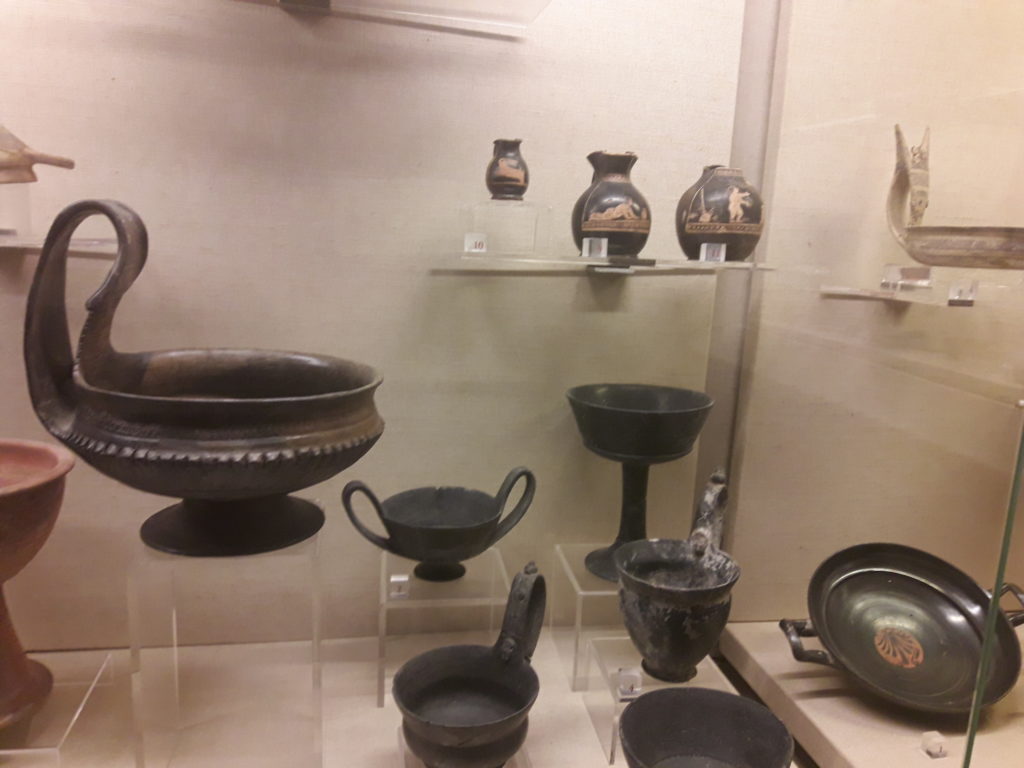
In the basement of the palace there is an imposing “beam press”, called “di Catone”, dating back to the eighteenth century and active until 1973, with a massive horizontal beam that crushed marcs with its weight. This type of press is described by the famous agronomist in the treatise De Agri Cultura in the first century BC. Later, Pliny described another type of press, called “screw press”, which represented an innovation in the agricultural field, allowing greater productivity in smaller spaces.
There is a succession of medieval, renaissance, baroque, modern and contemporary ceramics, engravings and drawings from the fifteenth to the twentieth century, original editions of precious treatises on viticulture (as Andrea Bacci “De naturali vinorum historia de vinis Italiae”, 1596), goldsmith’s art and textiles.
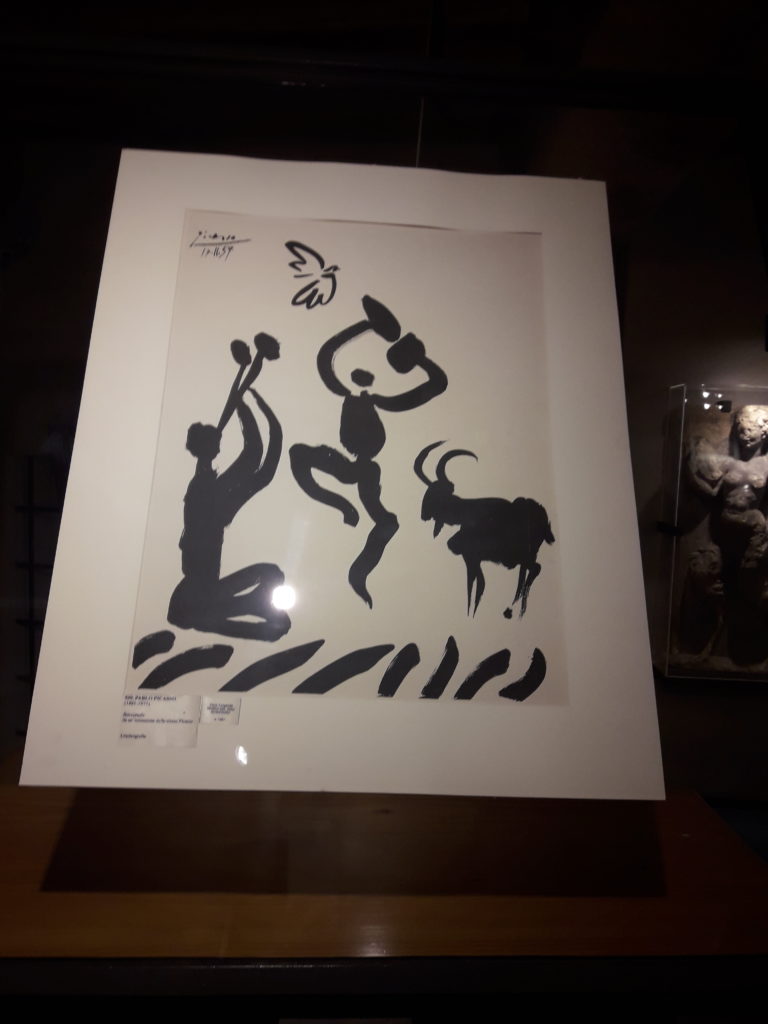
All this is a precious witness of the importance that the culture of vine and wine has played in the collective and social imagination of the populations of the Mediterranean basin and continental Europe over the centuries.
The meaning of wine as an economic activity linked to the sustenance of agricultural communities emerges, at the same time the Dionysian dimension, ritual and sacred, is present, finally the social and convivial aspect is shown, as reasons through which it is possible to retrace in a perspective and critical key the history of civilizations.
The first room is striking for the depiction on the back wall of a load of amphorae, while real wine amphorae are placed in the foreground. In the center stands a precious Greek kylix (the cup destined to drink wine during the sumposium) dating from the sixth century BC, made by one of the most famous Little Masters, bearing the inscription “Phrinos made me so cheerful”.
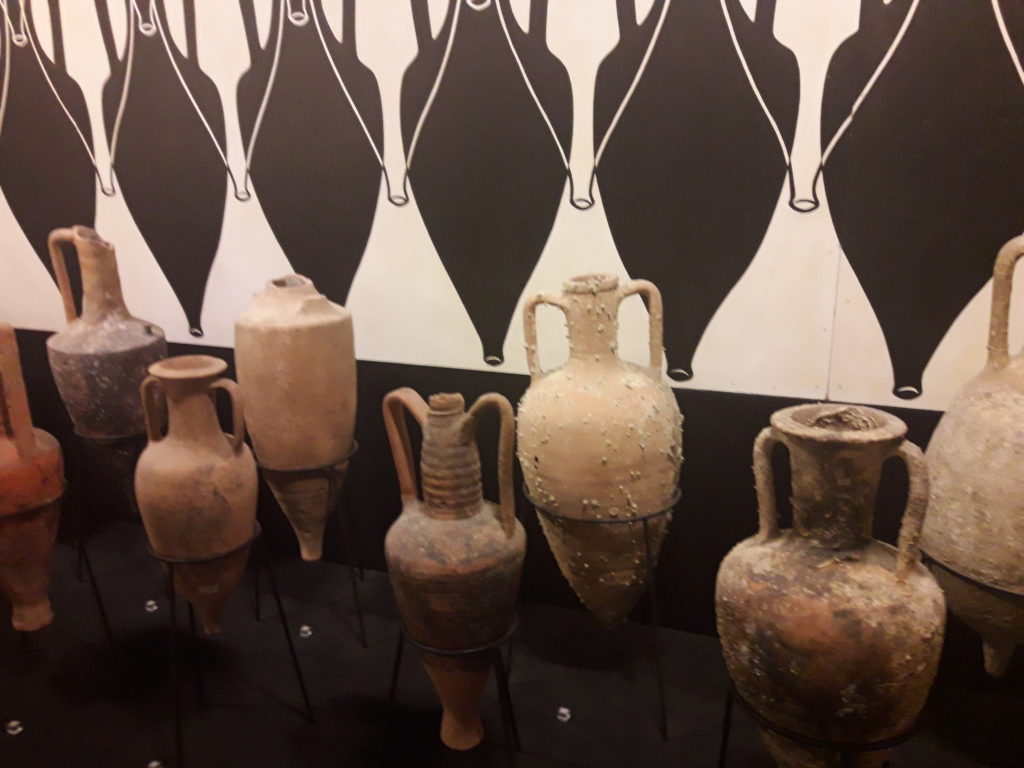
Aspects of the typical Umbrian wine-growing landscape are represented, linked to the “married vine” to the tree, in the form of “alberata” (single trees) and “piantata” (trees connected to each other by branches).
Strongly present is the symbolic and allegorical dimension of wine in the history of art, such as the reinterpretation of Ovid, Boccaccio and Poliziano themes on jugs and ceramics from the Renaissance period in a sacred or profane key: wine as food, as medicine, as mith. Among the precious Reinaissance ceramics stands a delicious “piatto” (plate) by Mastro Giorgio Andreoli, depicting “Bacchus’ childhood” dated 1528 and a bust from Bottega della Robbia which depicts Bacchus.
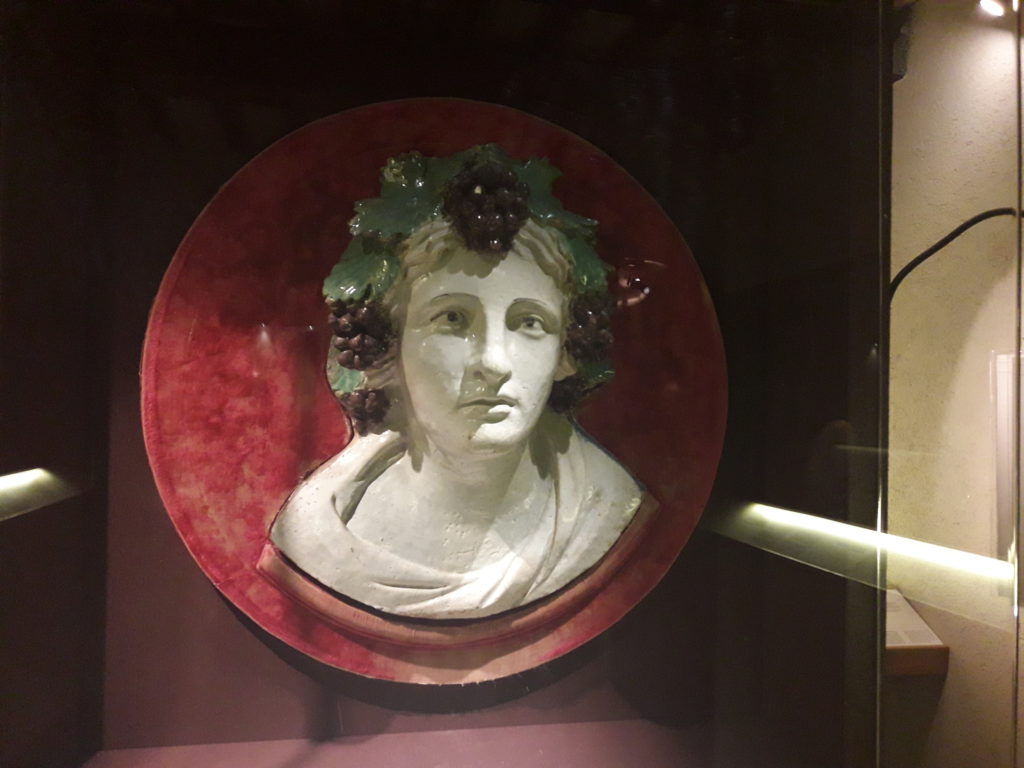
Among the thousand pieces that tell history and beauty, one of the protagonists is the famous Fiasca from Bottega di Orazio Fontana, a polychrome majolica decorated with themes taken from Raffaello and Giulio Romano, made in the famous Bottega in Urbino, between 1565 and 1570. The Fiasca has relief handles shaping masks that become volutes in the lower part. It is a splendid memory of an art that created sumptuous ceramics to embellish and give prestige to the Principe’s banquets that took place in the Renaissance Courts.
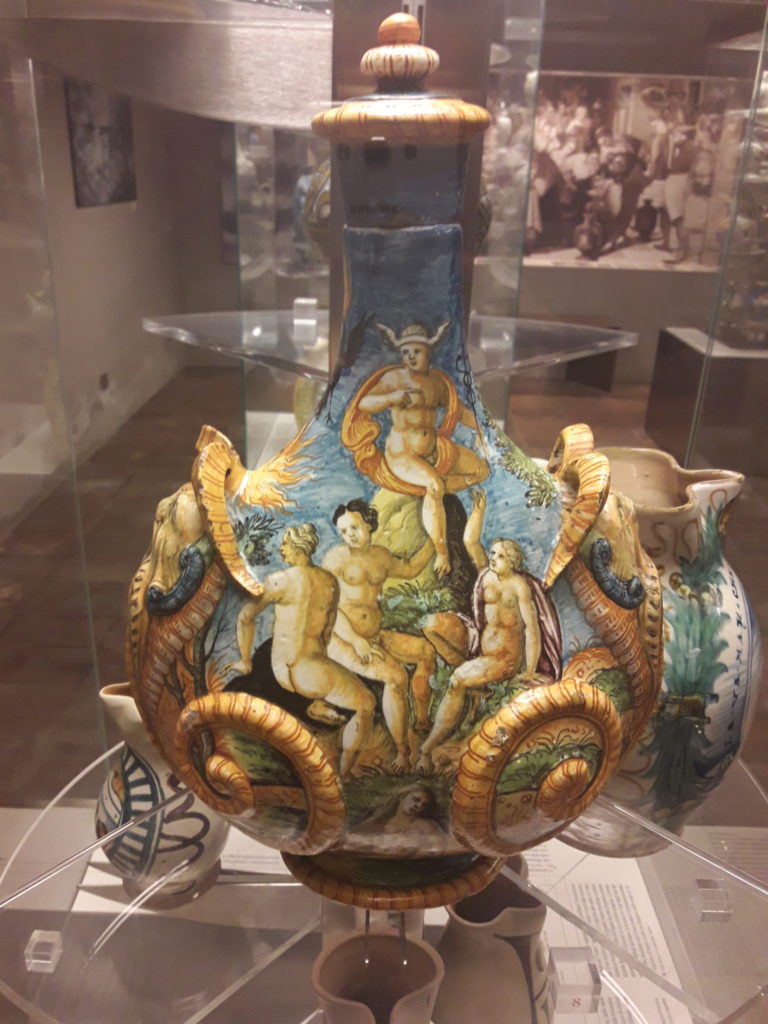
Among the curiosities related to the playful aspects of Renaissance banquets, there are the so called “bevi se puoi” (drink if you can) or “coppe ad inganno” (deception cups), or “caraffe burlone” (jokers jugs): cups and jugs of different shape with various holes, which allowed you to drink only if you discovered the deception. That is, only if the holes were closed at certain points, allowing wine to get to the right exit hole. Otherwise, wine came out from the side holes and the drinker would get wet with wine, provoking the hilarity of the guests.
At the end of this journey, we come to the present with precious pieces as the “Anthropomorphic Vase” by Jean Cocteau, of extraordinary beauty, and the “Mum bottle”, designed by Joe Ponti and made in 1994 by “Cooperativa Ceramica d’Imola” (historic manufacture active since the late nineteenth century), a metaphor of wine as a link between past and present.
Wine, as a symbol of culture and civilization, finds in “Museo del Vino” one of its greatest expressions.
Notes:
[1] Maria Grazia Marchetti Lungarotti, Mario Torelli, Vino: tra mito e cultura, Skira, 2006
[2] Museo del vino di Torgiano, Materiali archeologici, Electa, Editori Umbri associati, 1997
[3] Alberto Grohmann, Il vino, l’olio, la terra. Dal territorio alla tavola nell’età del Perugino, Silvana editoriale, 2004
[4] Piero Pasini, Ruggero Ragonese, Umbria, EDT edizioni
[5] Attilio Scienza, Andrea Zanfi, Italia Terre da Vino, SeB editori, Prato (FI), 2016